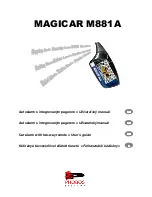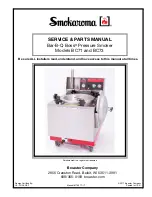
FFP9VH
PHOTOELECTRIC SMOKE ALARM
WITH 9 VOLT BATTERY &
TEST & HUSH BUTTON
SPECIFICATIONS:
Detection Type
Photoelectric Chamber
Power Source
9V DC Battery
Standby Current
15uA max
Alarm Current
30mA max
Alarm Sound Level
85 Decibels at 3 metres
Operation Temperature
5°C to 45°C
Ambient Humidity
10% to 90%
Sensitivity to Smoke
3.0 - 6.0% Obs/m
Compact Size
110mm diameter
FEATURES:
DC operated photoelectric type smoke alarm
Photoelectic sensor for slow smouldering fires
Insect proof
Test & Hush button
Environmentally friendly non-radioactive technology
High and stable sensitivity
Quick fix mounting bracket for easy installation
Fitting and battery tamper-resist feature
LED operation indicator
Extra loud alarm sound over 85 dB
Low-battery and battery missing warning indicators
Auto reset when smoke clears
IMPORTANT:
This manual contains important
information about the installation and operation of
your smoke alarm. Please read carefully before
installation and keep for future reference. Please
ensure that this leaflet remains in the household
where the alarm is installed.
WARNING:
This smoke alarm is designed to alert
you to the presence of smoke. It cannot prevent a
fire. There are hazards against which smoke
alarms may not be effective such as smoking in
bed, explosions, etc. The ultimate responsibility for
fire protection rests with you. This responsibility
includes escape planning, safety checks and an
effective warning system. In case of fire, a well
placed, properly looked after smoke alarm may
provide a few seconds so that you can escape and
call the fire brigade.
IMPORTANT SAFETY INFORMATION
1. This smoke alarm requires a constant working 9
volt battery to operate properly. This smoke alarm
will NOT work if DC power is not connected, has
failed or has been interrupted for any reason, the
battery is removed, drained or improperly
connected. DO NOT use any other kind of battery
PRODUCT MANUAL
BEDROOM
HALL
BEDROOM
LIVING ROOM
KITCHEN
BASEMENT
MULTI-STOREY RESIDENCE
KEY:
Minimum required smoke alarm locations
Recommended additional smoke alarm locations
Smoke alarms with hush features recommended
for additional protection
DINING ROOM
LIVING ROOM
BEDROOM
BEDROOM
KITCHEN
SINGLE-STOREY RESIDENCE, APARTMENT, MOBILE HOME
except as specified.
2. DO NOT connect this smoke alarm to any other
type of smoke alarm or auxiliary device, except
those listed in this manual. The test button
accurately tests all smoke alarm functions. DO
NOT use any other test method. Test smoke alarm
weekly to ensure proper operation.
3. DO NOT remove or disconnect battery to silence
unwanted alarms. This will remove your protection.
Open windows or ventilate the smoke alarm to
silence it.
4. This smoke alarm may be installed by a licensed,
qualified electrician. Observe and follow all local
and national electrical and building codes for
installation.
5. This smoke alarm is designed to be used inside
a single unit dwelling only. In buildings with several
dwellings, each individual living unit should have its
own smoke alarms. DO NOT install in
non-residential buildings. This smoke alarm is not a
substitute for a complete alarm system.
6. Install a smoke alarm in every room and on every
level of the home. Smoke may not reach the smoke
alarm for many reasons. For example, if a fire starts
in a remote part of the home, on another level, in a
chimney, wall, roof or on the other side of a closed
door, smoke may not reach the smoke alarm in
time to alert household members. A smoke alarm
will not promptly detect a fire except in the area or
room in which it is installed.
7. Smoke alarms may not alert every household
member every time. The alarm sound is loud in
order to alert individuals to a potential danger.
However, there may be limiting circumstances
where a household member may not hear the
alarm (i.e. outdoor or indoor noise, sound sleepers,
drug or alcohol usage, hard of hearing, etc.). If you
suspect that this smoke alarm may not alert
household members, install and maintain specialty
alarms. Household members must hear the alarm’s
warning sound and respond, to quickly reduce the
risk of damage, injury or death that may result from
fire. If a household member is hearing impaired,
install special smoke alarms with lights or vibrating
devices to alert occupants.
8. Smoke alarms can only sound their alarms when
they detect smoke. Smoke alarms detect
combustion particles in the air. They do not sense
heat, flame or gas. This smoke alarm is designed to
give an audible warning of a developing fire.
However, many fires are fast burning, explosive or
intentional. Others are caused by carelessness or
safety hazards. Smoke may not reach the smoke
alarm quickly enough to ensure safe escape.
9. Smoke alarms have limitations. This smoke
alarm is not foolproof and is not warranted to
protect lives or property from fire. Smoke alarms
are not a substitute for insurance. Homeowners
and renters should insure their lives and property.
In addition, it is possible for the smoke alarm to fail
at any time. For this reason, you must test the
smoke alarm weekly and replace every 10 years.
NOTE:
For best protection, we recommend that
you install a smoke alarm in every room.
WHERE TO INSTALL YOUR ALARM
For best safety, install smoke alarms in every
room: Including hall, bedrooms, living rooms,
attics & basement. At the very least, install one
smoke alarm on every floor.
SMOKE ALARM PLACEMENT
Typical single-storey home
Install a smoke alarm on the ceiling or wall inside
each bedroom and in the hallway outside each
separate sleeping area. If a bedroom area or
hallway is more than 9 metres long, install a smoke
alarm at each end. If there is a basement, install a
smoke alarm on the basement ceiling at the bottom
of the stairwell.
IMPORTANT SMOKE ALARM PLACEMENT
AND EXCEPTION INFORMATION
1. Place as close as possible to the centre of the
ceiling as possible or at least no closer than 30cm
to any wall or corner.
2. Install a smoke alarm in each room that is
divided by a partial wall.
3. Install a smoke alarm in lived-in attics or attics
which house electrical equipment like furnaces, air
conditioners or heaters.
DO NOT INSTALL SMOKE ALARMS
1. Areas near appliances or where normal
combustion regularly occurs (near furnaces, hot
water heaters).
2. In areas with high humidity, like bathrooms, near
dishwashers or washing machines. Install at least
3 metres away from these areas.
3. Air returns or heating and cooling supply vents.
Install at least 900mm away from these areas. The
air could blow smoke away from the detector,
interrupting it’s alarm.
4. In rooms where temperatures may fall below
5ºC or rise above 45ºC.
5. In extremely dusty, dirty, or insect-infested areas
where loose particles interfere with smoke alarm
operation.
WARNING:
Incorrect orientation will result in a
decrease in operational effectiveness.
Typical multi-storey or split level home
Install a smoke alarm on the ceiling or wall inside
each bedroom and in the hallway outside each
separate sleeping area. If a bedroom area or
hallway is more than 9 metres long, install a
smoke alarm at each end. Please install a smoke
alarm on the top of a first-to-second floor stairwell.
Heat and
smoke
from fire
Best here
Dead air space,
do not install here
30cm
minimum
30cm minimum
Dead air space,
do not install here
90cm
minimum
Best here
®
AS3786
Lic SMKH21554
SAI Global




















